Search
- Page Path
- HOME > Search
- [Korean]
- 3D-Printed Stretchable Electrodes Enabled by a Titanium/Acrylamide-Based Hydrogel Nanocomposite
- Se Jin Choi, Han Eol Lee
- J Powder Mater. 2025;32(1):67-72. Published online February 28, 2025
- DOI: https://doi.org/10.4150/jpm.2024.00465
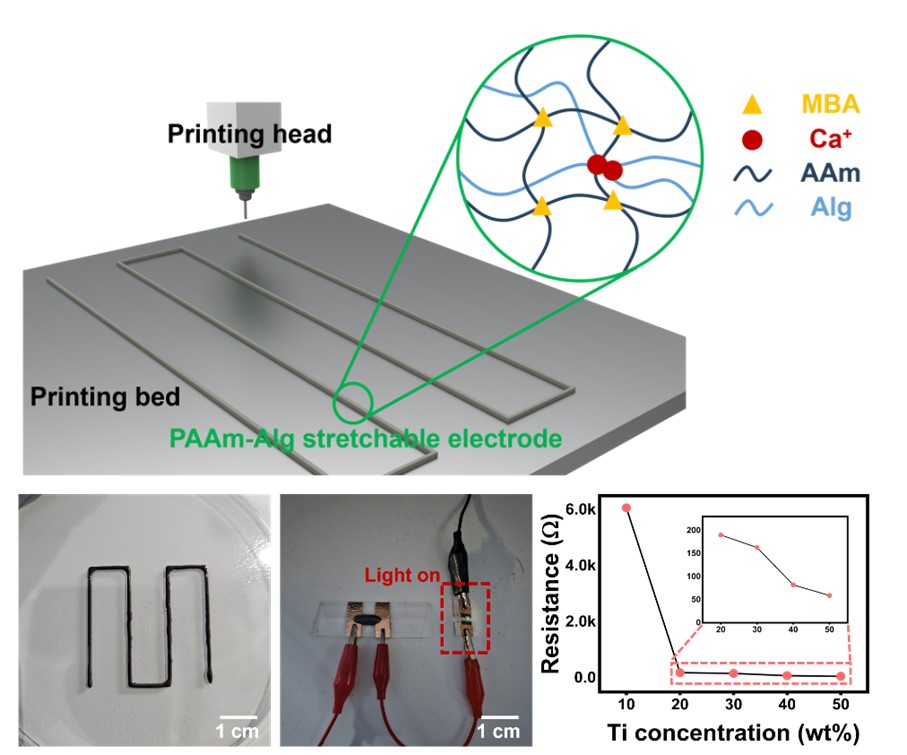
- 148 View
- 7 Download
-
 Abstract
Abstract
 PDF
PDF - Wearable electronics have been the focus of considerable interest in various fields, such as human-machine interfaces, soft robotics, and medical treatments, due to their flexibility, stretchability, and light weight. To address the shortcomings of existing metal thin film-based wearable devices, stretchable conductive polymers have been developed. In particular, double networking hydrogels are being actively studied as a polymer with a three-dimensional stereoscopic structure that can be patterned. Nonetheless, they have shortcomings such as poor electrical properties and cumbersome manufacturing processes, making it difficult to apply them in electronic devices. Herein, we report 3D-printed stretchable electrodes enabled by a titanium/polyacrylamide-alginate-based hydrogel nanocomposite. This research suggests the strategy for resolving the challenges of high costs and complex fabrication processes associated with stretchable electrode, providing a solution to accelerate the commercialization of wearable electronic devices.
- [Korean]
- Capacitance Enhancement and Evaluation of Gold-Deposited Carbon Nanotube Film Ion-Selective Electrode
- Do Youn Kim, Hanbyeol Son, Hyo-Ryoung Lim
- J Powder Mater. 2023;30(4):310-317. Published online August 1, 2023
- DOI: https://doi.org/10.4150/KPMI.2023.30.4.310
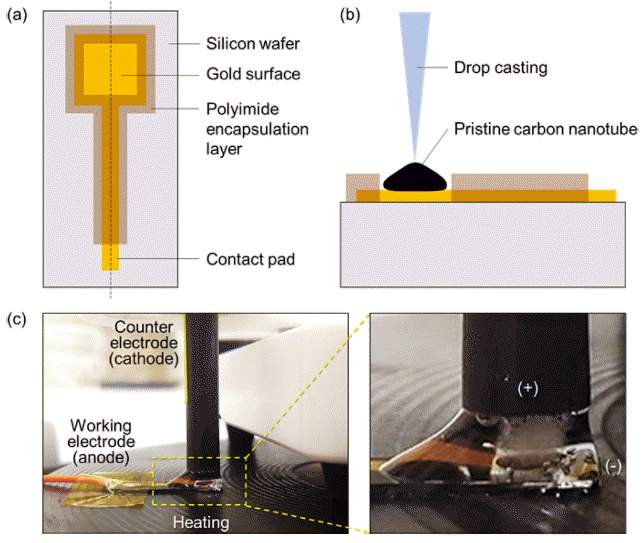
- 211 View
- 4 Download
-
 Abstract
Abstract
 PDF
PDF Small-film-type ion sensors are garnering considerable interest in the fields of wearable healthcare and home-based monitoring systems. The performance of these sensors primarily relies on electrode capacitance, often employing nanocomposite materials composed of nano- and sub-micrometer particles. Traditional techniques for enhancing capacitance involve the creation of nanoparticles on film electrodes, which require cost-intensive and complex chemical synthesis processes, followed by additional coating optimization. In this study, we introduce a simple one-step electrochemical method for fabricating gold nanoparticles on a carbon nanotube (Au NP–CNT) electrode surface through cyclic voltammetry deposition. Furthermore, we assess the improvement in capacitance by distinguishing between the electrical double-layer capacitance and diffusion-controlled capacitance, thereby clarifying the principles underpinning the material design. The Au NP–CNT electrode maintains its stability and sensitivity for up to 50 d, signifying its potential for advanced ion sensing. Additionally, integration with a mobile wireless data system highlights the versatility of the sensor for health applications.
- [Korean]
- Comparison Study of Compact Titanium Oxide (c-TiO2) Powder Electron Transport Layer Fabrication for Carbon Electrode-based Perovskite Solar Cells
- Chae Young Woo, Hyung Woo Lee
- J Powder Mater. 2022;29(4):297-302. Published online August 1, 2022
- DOI: https://doi.org/10.4150/KPMI.2022.29.4.297
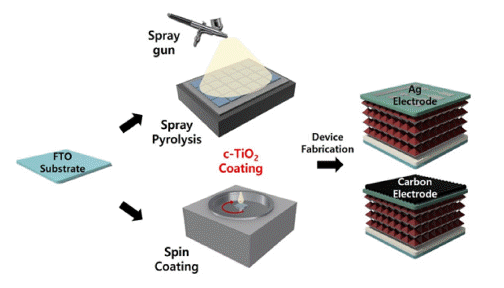
- 393 View
- 7 Download
-
 Abstract
Abstract
 PDF
PDF This study compares the characteristics of a compact TiO2 (c-TiO2) powdery film, which is used as the electron transport layer (ETL) of perovskite solar cells, based on the manufacturing method. Additionally, its efficiency is measured by applying it to a carbon electrode solar cell. Spin-coating and spray methods are compared, and spraybased c-TiO2 exhibits superior optical properties. Furthermore, surface analysis by scanning electron microscopy (SEM) and atomic force microscopy (AFM) exhibits the excellent surface properties of spray-based TiO2. The photoelectric conversion efficiency (PCE) is 14.31% when applied to planar perovskite solar cells based on metal electrodes. Finally, carbon nanotube (CNT) film electrode-based solar cells exhibits a 76% PCE compared with that of metal electrodebased solar cells, providing the possibility of commercialization.
- [Korean]
- Preparation of CoFe2O4 Nanoparticle Decorated on Electrospun Carbon Nanofiber Composite Electrodes for Supercapacitors
- Hyewon Hwang, Seoyeon Yuk, Minsik Jung, Dongju Lee
- J Korean Powder Metall Inst. 2021;28(6):470-477. Published online December 1, 2021
- DOI: https://doi.org/10.4150/KPMI.2021.28.6.470
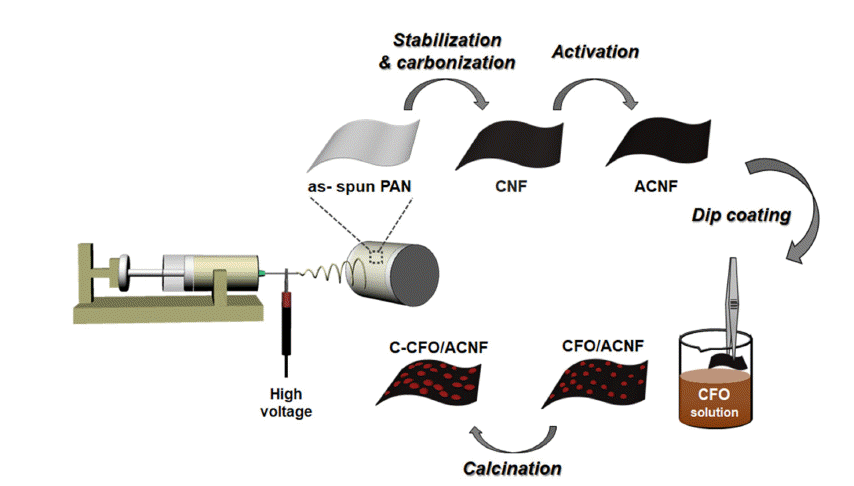
- 196 View
- 3 Download
-
 Abstract
Abstract
 PDF
PDF Energy storage systems should address issues such as power fluctuations and rapid charge-discharge; to meet this requirement, CoFe2O4 (CFO) spinel nanoparticles with a suitable electrical conductivity and various redox states are synthesized and used as electrode materials for supercapacitors. In particular, CFO electrodes combined with carbon nanofibers (CNFs) can provide long-term cycling stability by fabricating binder-free three-dimensional electrodes. In this study, CFO-decorated CNFs are prepared by electrospinning and a low-cost hydrothermal method. The effects of heat treatment, such as the activation of CNFs (ACNFs) and calcination of CFO-decorated CNFs (C-CFO/ACNFs), are investigated. The C-CFO/ACNF electrode exhibits a high specific capacitance of 142.9 F/g at a scan rate of 5 mV/s and superior rate capability of 77.6% capacitance retention at a high scan rate of 500 mV/s. This electrode also achieves the lowest charge transfer resistance of 0.0063 Ω and excellent cycling stability (93.5% retention after 5,000 cycles) because of the improved ion conductivity by pathway formation and structural stability. The results of our work are expected to open a new route for manufacturing hybrid capacitor electrodes containing the C-CFO/ACNF electrode that can be easily prepared with a low-cost and simple process with enhanced electrochemical performance.
- [Korean]
- Effect of Li2O-Bi2O3 Addition on the Piezoelectric Properties of Pb(Mg1/3Nb2/3)0.65Ti0.35O3 Ceramics
- Jae Hyuk Kim, Shi Yeon Kim, Jeoung Sik Choi, Dong-Hun Yeo, Hyo-Soon Shin, Sahn Nahm
- J Korean Powder Metall Inst. 2019;26(5):405-409. Published online October 1, 2019
- DOI: https://doi.org/10.4150/KPMI.2019.26.5.405

- 288 View
- 1 Download
-
 Abstract
Abstract
 PDF
PDF Piezoelectric ceramic specimens with the Pb(Mg1/3Nb2/3)0.65Ti0.35O3 (PMN-PT) composition are prepared by the solid state reaction method known as the “columbite precursor” method. Moreover, the effects of the Li2O-Bi2O3 additive on the microstructure, crystal structure, and piezoelectric properties of sintered PMN-PT ceramic samples are investigated. The addition of Li2O-Bi2O3 lowers the sintering temperature from 1,200°C to 950°C. Moreover, with the addition of >5 wt.% additive, the crystal structure changes from tetragonal to rhombohedral. Notably, the sample with 3 wt.% additive exhibits excellent piezoelectric properties (d33 = 596 pC/N and Kp = 57%) and a sintered density of 7.92 g/cm3 after sintering at 950°C. In addition, the sample exhibits a curie temperature of 138.6°C at 1 kHz. Finally, the compatibility of the sample with a Cu electrode is examined, because the energy-dispersive X-ray spectroscopy data indicate the absence of interdiffusion between Cu and the ceramic material.
- [Korean]
- Multicomponent IGZO Ceramics for Transparent Electrode Target Fabricated from Oxides and Nitrates
- Hyun-Kwun Lee, Ji-Hye Yoon, Kyeong-Sik Cho
- J Korean Powder Metall Inst. 2019;26(5):375-382. Published online October 1, 2019
- DOI: https://doi.org/10.4150/KPMI.2019.26.5.375

- 191 View
- 1 Download
-
 Abstract
Abstract
 PDF
PDF Homogeneous multicomponent indium gallium zinc oxide (IGZO) ceramics for transparent electrode targets are prepared from the oxides and nitrates as the source materials, and their properties are characterized. The selected compositions were In2O3:Ga2O3:ZnO = 1:1:2, 1:1:6, and 1:1:12 in mole ratio based on oxide. As revealed by X-ray diffraction analysis, calcination of the selected oxide or nitrides at 1200°C results in the formation of InGaZnO4, InGaZn3O6, and InGaZn5O8 phases. The 1:1:2, 1:1:6, and 1:1:12 oxide samples pressed in the form of discs exhibit relative densities of 96.9, 93.2, and 84.1%, respectively, after sintering at 1450°C for 12 h. The InGaZn3O6 ceramics prepared from the oxide or nitrate batches comprise large grains and exhibit homogeneous elemental distribution. Under optimized conditions, IGZO multicomponent ceramics with controlled phases, high densities, and homogeneous microstructures (grain and elemental distribution) are obtained.
- [Korean]
- The Effects of Hexamethylenetetramine Concentration on the Structural and Electrochemical Performances of Ni(OH)2 Powder for Pseudocapacitor Applications
- Dong Yeon Kim, Young-Min Jeong, Seong-Ho Baek, Injoon Son
- J Korean Powder Metall Inst. 2019;26(3):231-236. Published online June 1, 2019
- DOI: https://doi.org/10.4150/KPMI.2019.26.3.231
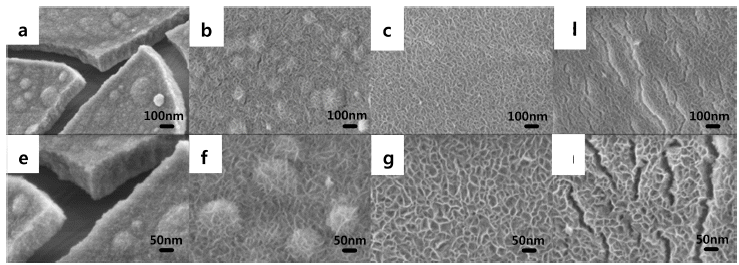
- 374 View
- 1 Download
- 1 Citations
-
 Abstract
Abstract
 PDF
PDF Ni hydroxides (Ni(OH)2) are synthesized on Ni foam by varying the hexamethylenetetramine (HMT) concentration using an electrodeposition process for pseudocapacitor (PC) applications. In addition, the effects of HMT concentration on the Ni(OH)2 structure and the electrochemical properties of the PCs are investigated. HMT is the source of amine-based OH− in the solution; thus, the growth rate and morphological structure of Ni(OH)2 are influenced by HMT concentration. When Ni(OH)2 is electrodeposited at a constant voltage mode of -0.85 V vs. Ag/AgCl, the cathodic current and the number of nucleations are significantly reduced with increasing concentration of HMT from 0 to 10 mM. Therefore, Ni(OH)2 is sparsely formed on the Ni foam with increasing HMT concentration, showing a layered double-hydroxide structure. However, loosely packed Ni(OH)2 grains that are spread on Ni foam maintain a much greater surface area for reaction and result in the effective utilization of the electrode material due to the steric hindrance effect. It is suggested that the Ni(OH)2 electrodes with HMT concentration of 7.5 mM have the maximum specific capacitance (1023 F/g), which is attributed to the facile electrolyte penetration and fast proton exchange via optimized surface areas.
-
Citations
Citations to this article as recorded by- Review of Domestic Research Trends on Layered Double Hydroxide (LDH) Materials: Based on Research Articles in Korean Citation Index (KCI)
Seon Yong Lee, YoungJae Kim, Young Jae Lee
Economic and Environmental Geology.2023; 56(1): 23. CrossRef
- Review of Domestic Research Trends on Layered Double Hydroxide (LDH) Materials: Based on Research Articles in Korean Citation Index (KCI)
- [Korean]
- Flexible Cu-In-Se Quantum Dot-Sensitized Solar Cells Based on Nanotube Electrodes
- Jae-Yup Kim
- J Korean Powder Metall Inst. 2019;26(1):45-48. Published online February 1, 2019
- DOI: https://doi.org/10.4150/KPMI.2019.26.1.45
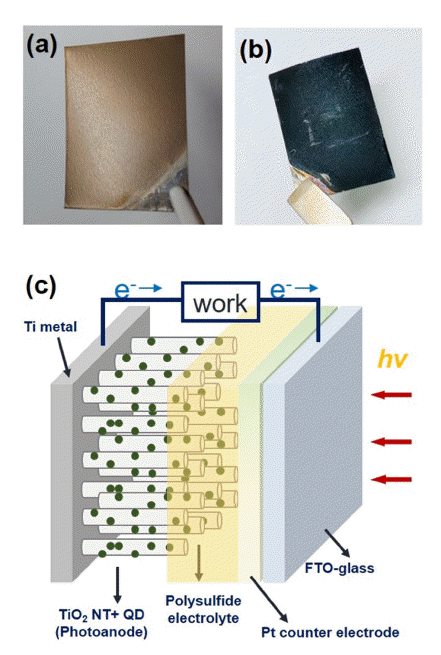
- 178 View
- 2 Download
-
 Abstract
Abstract
 PDF
PDF Quantum dots (QDs) are an attractive material for application in solar energy conversion devices because of their unique properties including facile band-gap tuning, a high-absorption coefficient, low-cost processing, and the potential multiple exciton generation effect. Recently, highly efficient quantum dot-sensitized solar cells (QDSCs) have been developed based on CdSe, PbS, CdS, and Cu-In-Se QDs. However, for the commercialization and wide application of these QDSCs, replacing the conventional rigid glass substrates with flexible substrates is required. Here, we demonstrate flexible CISe QDSCs based on vertically aligned TiO2 nanotube (NT) electrodes. The highly uniform TiO2 NT electrodes are prepared by two-step anodic oxidation. Using these flexible photoanodes and semi-transparent Pt counter electrodes, we fabricate the QDSCs and examine their photovoltaic properties. In particular, photovoltaic performances are optimized by controlling the nanostructure of TiO2 NT electrodes.
- [Korean]
- Photocatalytic Properties of WO3 Thin Films Prepared by Electrodeposition Method
- Kwang-Mo Kang, Ji-Hye Jeong, Ga-In Lee, Jae-Min Im, Hyun-Jeong Cheon, Deok-Hyeon Kim, Yoon-Chae Nah
- J Korean Powder Metall Inst. 2019;26(1):40-44. Published online February 1, 2019
- DOI: https://doi.org/10.4150/KPMI.2019.26.1.40

- 222 View
- 2 Download
- 1 Citations
-
 Abstract
Abstract
 PDF
PDF Tungsten trioxide (WO3) is a promising candidate as a photocatalyst because of its outstanding electrical and optical properties. In this study, we prepare WO3 thin films by electrodeposition and characterize the photocatalytic degradation of methylene blue using these films. Depending on the voltage conditions (static and pulse), compact and porous WO3 films are fabricated on a transparent ITO/glass substrate. The morphology and crystal structure of electrodeposited WO3 thin films are investigated by scanning electron microscopy, atomic force microscopy, and X-ray diffraction. An application of static voltage during electrodeposition yields a compact layer of WO3, whereas a highly porous morphology with nanoflakes is produced by a pulse voltage process. Compared to the compact film, the porous WO3 thin film shows better photocatalytic activities. Furthermore, a much higher reaction rate of degradation of methylene blue can be achieved after post-annealing of WO3 thin films.
-
Citations
Citations to this article as recorded by- Advanced IGZO Phototransistor Arrays: Enhancing Visible Light Detection Through Selectively Electrohydrodynamic Jet‐Printed Photocatalytic Layer Formation
Jong Bin An, Byung Ha Kang, Sujin Jung, Kunho Moon, Jusung Chung, Seok Min Hong, Kyungho Park, Jong Hyuk Ahn, Hyun Jae Kim
Advanced Functional Materials.2024;[Epub] CrossRef
- Advanced IGZO Phototransistor Arrays: Enhancing Visible Light Detection Through Selectively Electrohydrodynamic Jet‐Printed Photocatalytic Layer Formation
- [Korean]
- High-Contrast Electrochromism of Porous Tungsten Oxide Thin Films Prepared by Electrodeposition
- Sung-Hyeok Park, Ho-Jin Mo, Jae-Keun Lim, Sang-Gwon Kim, Jae-Hyo Choi, Seung-Hyun Lee, Se-Hwa Jang, Kyung-Ho Cha, Yoon-Chae Nah
- J Korean Powder Metall Inst. 2018;25(1):7-11. Published online February 1, 2018
- DOI: https://doi.org/10.4150/KPMI.2018.25.1.7

- 494 View
- 15 Download
- 1 Citations
-
 Abstract
Abstract
 PDF
PDF In this study, we synthesize tungsten oxide thin films by electrodeposition and characterize their electrochromic properties. Depending on the deposition modes, compact and porous tungsten oxide films are fabricated on a transparent indium tin oxide (ITO) substrate. The morphology and crystal structure of the electrodeposited tungsten oxide thin films are investigated by scanning electron microscopy (SEM) and X-ray diffraction (XRD). X-ray photoelectron spectroscopy is employed to verify the chemical composition and the oxidation state of the films. Compared to the compact tungsten oxides, the porous films show superior electrochemical activities with higher reversibility during electrochemical reactions. Furthermore, they exhibit very high color contrast (97.0%) and switching speed (3.1 and 3.2 s). The outstanding electrochromic performances of the porous tungsten oxide thin films are mainly attributed to the porous structure, which facilitates ion intercalation/deintercalation during electrochemical reactions.
-
Citations
Citations to this article as recorded by- A fast-response electrochromic device based on a composite gel film comprising triphenylamine derivatives and WO3
Xuejian Zhang, Jinming Zeng, Zipeng Xu, Mimi Zhu, Ping Liu
New Journal of Chemistry.2021; 45(12): 5503. CrossRef
- A fast-response electrochromic device based on a composite gel film comprising triphenylamine derivatives and WO3
- [Korean]
- Recent Developments in H2 Production Photoelectrochemical Electrode Materials by Atomic Layer Deposition
- Jeong Hwan Han
- J Korean Powder Metall Inst. 2018;25(1):60-68. Published online February 1, 2018
- DOI: https://doi.org/10.4150/KPMI.2018.25.1.60
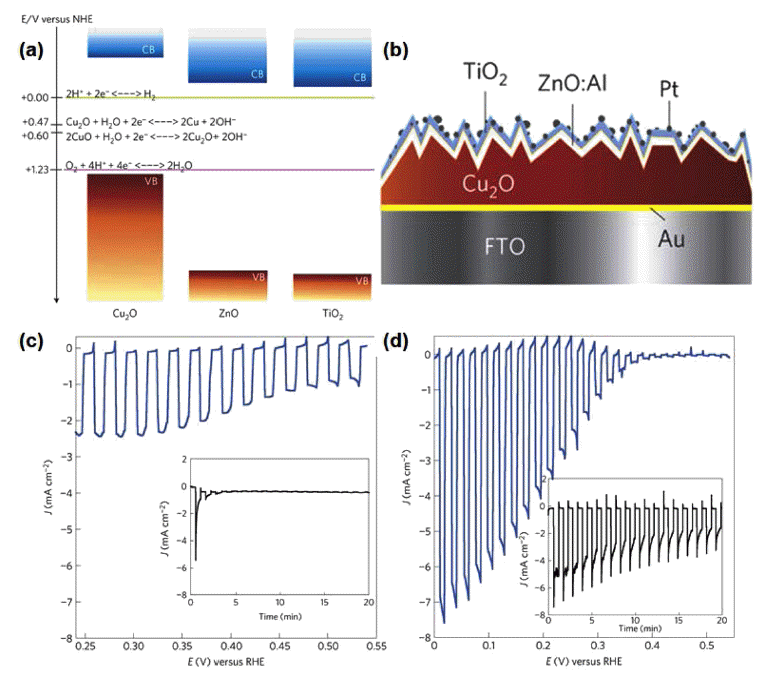
- 210 View
- 1 Download
- 1 Citations
-
 Abstract
Abstract
 PDF
PDF The design and fabrication of photoelectrochemical (PEC) electrodes for efficient water splitting is important for developing a sustainable hydrogen evolution system. Among various development approaches for PEC electrodes, the chemical vapor deposition method of atomic layer deposition (ALD), based on self-limiting surface reactions, has attracted attention because it allows precise thickness and composition control as well as conformal coating on various substrates. In this study, recent research progress in improving PEC performance using ALD coating methods is discussed, including 3D and heterojunction-structured PEC electrodes, ALD coatings of noble metals, and the use of sulfide materials as co-catalysts. The enhanced long-term stability of PEC cells by ALD-deposited protecting layers is also reviewed. ALD provides multiple routes to develop improved hydrogen evolution PEC cells.
-
Citations
Citations to this article as recorded by- Improved Interface and Electrical Properties by Inserting an Ultrathin SiO2 Buffer Layer in the Al2O3/Si Heterojunction
Doyeon Kim, Jae‐Young Choi, Sang Wook Ryu, Woo‐Byoung Kim
Advanced Functional Materials.2019;[Epub] CrossRef
- Improved Interface and Electrical Properties by Inserting an Ultrathin SiO2 Buffer Layer in the Al2O3/Si Heterojunction
- [Korean]
- Research Trends in Powder Materials for Solution-based Transparent Conducting Electrode
- Bon-Ryul Koo, Hyo-Jin Ahn
- J Korean Powder Metall Inst. 2017;24(2):153-163. Published online April 1, 2017
- DOI: https://doi.org/10.4150/KPMI.2017.24.2.153
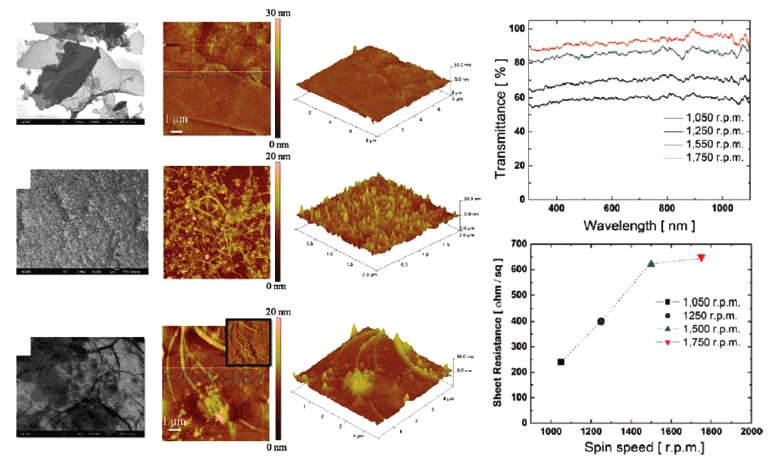
- 204 View
- 1 Download
- 1 Citations
-
 Abstract
Abstract
 PDF
PDF Transparent conducting electrodes (TCEs) are attracting considerable attention as an important component for emerging optoelectronic applications such as liquid crystal displays, touch panels, and solar cells owing to their attractive combination of low resistivity (< 10-3 Ω cm) and high transparency (>80%) in the visible region. The solutionbased process has unique properties of an easy fabrication procedure, scalability, and low cost compared to the conventional vacuum-based process and may prove to be a useful process for fabricating TCEs for future optoelectronic applications demanding large scale and flexibility. In this paper, we focus on the introduction of a solution-based process for TCEs. In addition, we consider the powder materials used to fabricate solution-based TCEs and strategies to improve their transparent conducting properties.
-
Citations
Citations to this article as recorded by- Electrically conductive and anti-corrosive coating on copper foil assisted by polymer-nanocomposites embedded with graphene
Han Kim, Hyemin Lee, Hyo-Ryoung Lim, Hong-Baek Cho, Yong-Ho Choa
Applied Surface Science.2019; 476: 123. CrossRef
- Electrically conductive and anti-corrosive coating on copper foil assisted by polymer-nanocomposites embedded with graphene
- [Korean]
- Spindle-shaped Fe2O3 Nanoparticle Coated Carbon Nanofiber Composites for Low-cost Dye-sensitized Solar Cells
- Dong-Hyeun Oh, HyeLan An, Bon-Ryul Koo, Hyo-Jin Ahn
- J Korean Powder Metall Inst. 2016;23(2):95-101. Published online April 1, 2016
- DOI: https://doi.org/10.4150/KPMI.2016.23.2.95

- 323 View
- 2 Download
- 1 Citations
-
 Abstract
Abstract
 PDF
PDF Carbon nanofiber (CNF) composites coated with spindle-shaped Fe2O3 nanoparticles (NPs) are fabricated by a combination of an electrospinning method and a hydrothermal method, and their morphological, structural, and chemical properties are measured by field-emission scanning electron microscopy, transmission electron microscopy, Xray diffraction, and X-ray photoelectron spectroscopy. For comparison, CNFs and spindle-shaped Fe2O3 NPs are prepared by either an electrospinning method or a hydrothermal method, respectively. Dye-sensitized solar cells (DSSCs) fabricated with the composites exhibit enhanced open circuit voltage (0.70 V), short-circuit current density (12.82 mA/cm2), fill factor (61.30%), and power conversion efficiency (5.52%) compared to those of the CNFs (0.66 V, 11.61 mA/cm2, 51.96%, and 3.97%) and spindle-shaped Fe2O3 NPs (0.67 V, 11.45 mA/cm2, 50.17%, and 3.86%). This performance improvement can be attributed to a synergistic effect of a superb catalytic reaction of spindle-shaped Fe2O3 NPs and efficient charge transfer relative to the one-dimensional nanostructure of the CNFs. Therefore, spindle-shaped Fe2O3-NPcoated CNF composites may be proposed as a potential alternative material for low-cost counter electrodes in DSSCs.
-
Citations
Citations to this article as recorded by- Ni Nanoparticles-Graphitic Carbon Nanofiber Composites for Pt-Free Counter Electrode in Dye-Sensitized Solar Cells
Dong-Hyeun Oh, Bon-Ryul Koo, Yu-Jin Lee, HyeLan An, Hyo-Jin Ahn
Korean Journal of Materials Research.2016; 26(11): 649. CrossRef
- Ni Nanoparticles-Graphitic Carbon Nanofiber Composites for Pt-Free Counter Electrode in Dye-Sensitized Solar Cells
- [Korean]
- Synthesis and Characterization of Nickel Nanowires by an Anodic Aluminum Oxide Template-Based Electrodeposition
- Hyo-Ryoung Lim, Yong-Ho Choa, Young-In Lee
- J Korean Powder Metall Inst. 2015;22(3):216-220. Published online June 1, 2015
- DOI: https://doi.org/10.4150/KPMI.2015.22.3.216

- 248 View
- 2 Download
-
 Abstract
Abstract
 PDF
PDF Vertically oriented nickel nanowire arrays with a different diameter and length are synthesized in porous anodic aluminium oxide templates by an electrodeposition method. The pore diameters of the templates are adjusted by controlling the anodization conditions and then they are utilized as templates to grow nickel nanowire arrays. The nickel nanowires have the average diameters of approximately 25 and 260 nm and the crystal structure, morphology and microstructure of the nanowires are systematically investigated using XRD, FE-SEM and TEM analysis. The nickel nanowire arrays show a magnetic anisotropy with the easy axis parallel to the nanowires and the coercivity and remanence enhance with decreasing a wire diameter and increasing a wire length.
TOP
 kpmi
kpmi


 First
First Prev
Prev


